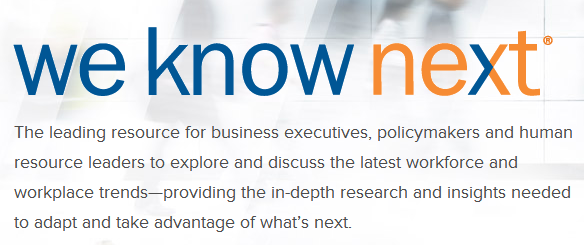#NEXTCHAT: Is HR Tech Really Making Our Jobs Easier?
Note: Today at 3:00PM ET, I will participate in SHRM's We Know Next #Nextchat, a Twitter conversation that SHRM has created to continue to explore important issues in the workplace. Below is the 'preview' post I wrote for today's #Nextchat.
There is no doubt that HR Technology plays an increasingly important role inside our organizations today. Whether simple, in-house developed tools for tracking employees in a very small organization, more complex and comprehensive ‘enterprise grade’ systems in use by most large organizations, or any of the myriad of newer HR technology solutions that are deployed via the web, in a Software-as-a-Service (SaaS) model - the influence and importance of workplace technology continues to grow.
But making sense of this fast-moving and changing market can be tough for the HR pro that has about a thousand other worries on their plate, and it can be easy, tempting, and expedient to only think about technology solutions as a kind of band-aid, or worse, as a necessary evil, deployed only to ensure essential processes like Payroll and Time Tracking get carried out correctly. And while today’s savvy HR professional knows there are a growing number of areas where new -- and existing -- solutions offer them, and the organization, fantastic opportunities to increase efficiency, gain better insights on their talent, and help leaders, managers, and employees make better decisions, it still can seem like a long climb -- and possibly an insurmountable one -- to get where they really want to be.
For several years, I taught in an HR Master’s degree program conducting a kind of seminar, or overview, of HR Technology, a pretty wide and deep subject, that’s getting more complex with each passing year. While we don’t have a 13-week semester together to talk and learn from each other about the state of HR Technology, we will try to hit some of the more important questions, ideas, and concepts in the HR Technology space today.
I’d like to see that the chat not be about specific solutions, really. Simply shouting out one product name or solution provider that you like or use, while it might make sense for you, often makes no sense at all, or doesn’t fit well in another organization. Rather, I think it will be more useful and beneficial to talk about the reasons behind why certain decisions were taken and certain projects were pursued, and to share more universal tips around getting a great return on your investment and supporting and promoting user adoption. That way we can focus on what matters more to HR professionals, and how to better think about, understand, and hopefully utilize HR Technology solutions in our organizations.
I am looking forward to the chat on August 15, and I hope you will be able to join in!
-----------------------------------------------------------------------------------
Please join @weknownext on August 15 at 3 p.m. ET for #Nextchat with Steve Boese (@SteveBoese). We’ll be chatting about HR Technology and will want to know your thoughts on the following questions:
Q1. What is ‘HR Technology’ anyway? What does HR technology encompass, and how is that changing?
Q2. What are some of the key considerations when making an investment in HR technology?
Q3. What are some ways HR can realize the expected benefits of technology investments?
Q4. How can the HR professional become better educated on the current HR technology market?
Q5. What are some of the leading-edge developments in workplace technology that the HR professional should understand?
Q6. What single HR or recruiting technology has made the largest positive impact in your organization?

 Steve
Steve

